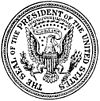
Back Kabinett Theodore Roosevelt German Présidence de Theodore Roosevelt French Presidenza di Theodore Roosevelt Italian Kabinet-Theodore Roosevelt Dutch Presidência de Theodore Roosevelt Portuguese
 | |
| Presidency of Theodore Roosevelt September 14, 1901 – March 4, 1909 | |
| Cabinet | See list |
|---|---|
| Party | Republican |
| Election | 1904 |
| Seat | White House |
|
| |
| Library website | |
The presidency of Theodore Roosevelt started on September 14, 1901, when Theodore Roosevelt became the 26th president of the United States upon the assassination of President William McKinley, and ended on March 4, 1909. Roosevelt had been the vice president for only 194 days when he succeeded to the presidency. A Republican, he ran for and won by a landslide a four-year term in 1904. He was succeeded by his protégé and chosen successor, William Howard Taft.
A Progressive reformer, Roosevelt earned a reputation as a "trust buster" through his regulatory reforms and antitrust prosecutions. His presidency saw the passage of the Pure Food and Drug Act, which established the Food and Drug Administration to regulate food safety, and the Hepburn Act, which increased the regulatory power of the Interstate Commerce Commission. Roosevelt took care, however, to show that he did not disagree with trusts and capitalism in principle, but was only against monopolistic practices. His "Square Deal" included regulation of railroad rates and pure foods and drugs; he saw it as a fair deal for both the average citizen and the businessmen. Sympathetic to both business and labor, Roosevelt avoided labor strikes, most notably negotiating a settlement to the great Coal Strike of 1902. He vigorously promoted the conservation movement, emphasizing efficient use of natural resources. He dramatically expanded the system of national parks and national forests.
In foreign affairs, Roosevelt sought to uphold the Monroe Doctrine and to establish the United States as a strong naval power, he took charge of building the Panama Canal, which greatly increased access to the Pacific and increased American security interests and trade opportunities. He ended the United States Military Government in Cuba and committed to a long-term occupation of the Philippines. Much of his foreign policy focused on the threats posed by Japan in the Pacific and Germany in the Caribbean. Seeking to minimize European power in Latin America, he mediated the Venezuela Crisis and declared the Roosevelt Corollary. Roosevelt mediated the Russo-Japanese War (1904–1905), for which he won the 1906 Nobel Peace Prize. He pursued closer relations with Great Britain. Biographer William Harbaugh argues:
- In foreign affairs, Theodore Roosevelt’s legacy is judicious support of the national interest and promotion of world stability through the maintenance of a balance of power; creation or strengthening of international agencies, and resort to their use when practicable; and implicit resolve to use military force, if feasible, to foster legitimate American interests. In domestic affairs, it is the use of government to advance the public interest. "If on this new continent," he said, "we merely build another country of great but unjustly divided material prosperity, we shall have done nothing."[1]
Historian Thomas Bailey wrote, "Roosevelt was a great personality, a great activist, a great preacher of the moralities, a great controversialist, a great showman. He dominated his era as he dominated conversations...the masses loved him; he proved to be a great popular idol and a great vote-getter."[2] His image stands alongside George Washington, Thomas Jefferson and Abraham Lincoln on Mount Rushmore. He is frequently ranked by historians among the five greatest U.S. presidents of all time.[3][4]
- ^ William H. Harbaugh, "Roosevelt, Theodore (27 October 1858–06 January 1919)" American National Biography (1999) online
- ^ Thomas A. Bailey, Presidential Greatness (1966) p. 308
- ^ "Impact and Legacy", Biography, American President, The Rector and Visitors of the University of Virginia, 2005, archived from the original on April 18, 2005, retrieved March 7, 2006.
- ^ "Legacy", T Roosevelt, PBS, archived from the original on April 17, 2004, retrieved March 7, 2006.
